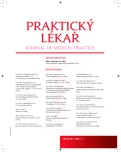Effect of selenium nanoparticles on pathogenic bacterial cultures and yeasts
Authors:
D. Hegerová 1,2; K. Číhalová 1,2; P. Sedláček 3; R. Veselý 4; P. Kopel 1,2; V. Adam 1,2; R. Kizek 5
Authors‘ workplace:
Mendelova univerzita v Brně
Ústav chemie a biochemie
Vedoucí: prof. RNDr. Vojtěch Adam, Ph. D.
1; Vysoké učení technické v Brně
Středoevropský technologický institut
Vedoucí: prof. Ing. Radimír Vrba, CSc.
2; MedicProgress, a. s., Olomouc
Ředitel: Ing. Pavel Sedláček
3; Klinika traumatologie
Lékařská fakulta Masarykovy univerzity a Úrazová nemocnice v Brně
Vedoucí: prof. MUDr. Miloš Janeček, CSc.
4; Lékařská univerzita Wroclaw
Vedoucí: prof. Dr. Halina Milnerowitz, Ph. D.
5
Published in:
Prakt. Lék. 2016; 96(1): 18-24
Category:
Of different specialties
Overview
Issue of bacterial and yeast infections with complicated course of treatment due to resistance of agents of these diseases are a frequent topic of research in the field of human and veterinary medicine. In this study, we focused on the study of selenium nanoparticles effect in the form of a gel-like complex with a polymer substance Cekol (SeNPs) as possible alternative to antibiotic drugs, in the elimination of bacterial and yeast infections. Testing of complex was carried out on the bacterial and yeast isolates obtained from a cohort of 450 patients from the Department of Traumatology at Trauma Hospital in Brno, from which it was taken always one swab sample from a superficial skin infection and to date have managed to identify in total 74 sub-species of bacterial strains or yeasts. To identify strains and tests of SeNPs microbiological, molecular-biological and mass spectrometry methods were used.
The study demonstrated a significant effect of this product on the bacterial strains and yeasts, regardless of their morphology. The growth of most strains from the file was managed by application of nanoparticles completely eliminated. However, in all cases this growth was at least largely suppressed. Sizes of inhibition zones, which can be regarded as effective (1), ranged from 5–20 mm. Our results describe significant antimicrobial effects based on nanotechnologies, which can be used to reduce the risk of uncontrolled infections in comparison with conventional antibiotic therapy.
Keywords:
bacteria – yeast – pathogenicity – infections – selenium nanoparticles – inhibition
Sources
1. Clinical and laboratory standards institute [online]. Dostupné z: http://clsi.org/
2. Zacharioudakis IM, Zervou FN, Ziakas PD, et al. Meta-analysis of methicillin-resistant Staphylococcus aureus colonization and risk of infection in dialysis patients. J Am Soc Nephrol 2014; 25 : 2131–2141.
3. van Hal SJ, Fowler VG. Is it time to replace vancomycin in the treatment of methicillin-resistant Staphylococcus aureus infections? Clin Infect Dis 2013; 56 : 1779–1788.
4. Chung DR, Baek JY, Kim HA, et al. First report of vancomycin-intermediate resistance in sequence type 72 community genotype methicillin-resistant Staphylococcus aureus. J Clin Microbiol 2012; 50 : 2513–2514.
5. Kopel P, Milosavljevic V, Moulick A, et al. Komplex biopolymerní látky s nanočásticemi selenu a antibiotickými léčivy s antibakteriálním účinkem. In: Ú.p. vlastnictvi (ed.), Mendelova univerzita v Brně, Česká republika 2014; 1–6.
6. Chudobova D, Cihalova K, Dostalova S, et al. Comparison of the effects of silver phosphate and selenium nanoparticles on Staphylococcus aureus growth reveals potential for selenium particles to prevent infection. FEMS Microbiol Lett 2014; 351 : 195–201.
7. Chudobova D, Dostalova S, Ruttkay-Nedecky B, et al. The effect of metal ions on Staphylococcus aureus revealed by biochemical and mass spectrometric analyses. Microbiol Res 2015; 170 : 147–156.
8. Chudobova D, Nejdl L, Gumulec J, et al. Complexes of silver(I) Ions and silver phosphate nanoparticles with hyaluronic acid and/or chitosan as promising antimicrobial agents for vascular grafts. Int J Mol Sci 2013; 14 : 13592–13614.
9. Cihalova K, Chudobova D, Milosavljevic V, et al. Modern techniques of increase the antibacterial properties of the instrument. J Met Nanotechnol 2014; 1 : 49–54.
10. Chudobova D, Cihalova K, Kopel P, et al. Complexes of metal-based nanoparticles with chitosan suppressing the risk of Staphylococcus aureus and Escherichia coli infections. In: Rai M, Kon K. (eds.). Nanotechnology in diagnosis, treatment and prophylaxis of infectious diseases. Amsterdam: Academic Press 2015; 217–232.
11. Grigor’eva A, Saranina I, Tikunova N, et al. Fine mechanisms of the interaction of silver nanoparticles with the cells of Salmonella typhimurium and Staphylococcus aureus. Biometals 2013; 26 : 479–488.
12. Tran PA, Webster TJ. Selenium nanoparticles inhibit Staphylococcus aureus growth. Int J Nanomed 2011; 6 : 1553–1558.
13. Cihalova K, Chudobova D., Michalek P, et al. Staphylococcus aureus and MRSA growth and biofilm formation after treatment with antibiotics and senps. Int J Mol Sci 2015; 16 : 24656–24672.
14. Klodzinska E, Kupczyk W, Jackowski M, et al. Capillary electrophoresis in the diagnosis of surgical site infections. Electrophoresis 2013; 34 : 3206–3213.
15. Fon Sing S, Isdepsky A, Borowitzka MA, et al. Pilot-scale continuous recycling of growth medium for the mass culture of a halotolerant Tetraselmis sp. in raceway ponds under increasing salinity: a novel protocol for commercial microalgal biomass production. Bioresource Technol 2014; 161 : 47–54.
16. Chudobova D, Cihalova K, Guran R, et al. Influence of microbiome species in hard-to-heal wounds on disease severity and treatment duration. Braz J Inf Dis 2015 (in press).
17. Ho CH, Odermatt EK, Berndt I, et al. Long-term active antimicrobial coatings for surgical sutures based on silver nanoparticles and hyperbranched polylysine. J Biomater Sci 2013; 24 : 1589–1600.
18. Kopel P, Chudobova D, Cihalova K, et al. Antibakteriální přípravek na bázi oxidu grafenu a redukovaného oxidu grafenu s obsahem nanočástic kovů a polokovů. In: Ú.p. vlastnictví (Ed.), Mendelova univerzita v Brně, Česká republika 2015; 1–6.
19. Sauer S, Freiwald A, Maier T, et al. Classification and identification of bacteria by mass spectrometry and computational analysis. Plos One 2008; 3 : 1–10.
Labels
General practitioner for children and adolescents General practitioner for adultsArticle was published in
General Practitioner

2016 Issue 1
Most read in this issue
- Consequentialism, deontologism, and medical ethics
- Principles of person-centred health care
- Patient’s stress in hospital, disposition, empathy
- Process of age-related decline of brain function among non-smokers and smokers
